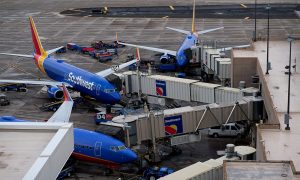U.S. airlines were deregulated in 1978. Railroads were deregulated in 1980.
Well, not really.
While operating ostensibly as private business for three decades, commercial transportation companies are required to disclose virtually every detail of their operations to various federal, and sometimes state or local, government agencies. This is true for privately held companies as well as ones that are publicly traded.
Once these exhaustive statistics were available only to media organizations rich enough to buy subscriptions from government vendors. Now all you need is the Internet and elementary-level proficiency on Excel.
These statistics provide the essential grounding – along with shoe leather – in covering transportation in local communities.
Digging into the data
The bible of transportation data is the web site of the U.S. Bureau of Transportation Statistics. Many reporters know BTS for its airline statistics, but it also features operating numbers on freight railroads and other modes. The types of data available on the BTS are too numerous to list here; spend a few hours on the site to get familiar with it. Its archive goes back decades. (I recently used it on deadline to find the average load factor, the percentage of available seats occupied by paying passengers , on U.S. airlines in 1973). This information is not just national. There are links to break down information to any of the approximately 450 U.S. airports that have commercial flights.
Through BTS and the monthly consumer reports from the U.S. Department of Transportation, a reporter in, say, Poughkeepsie, New York, can maintain a running report what percentage of the airport’s flights arrive and depart on time, how many passengers the flights carry and, for many cities, their most popular destinations. For the 30 largest airports, the DOT breaks out the percentage of flights that arrived on time each month for every one-hour block of the day from 6 a.m. through 11 p.m. Monthly numbers on departures and arrivals for every commercial airport are available on the Federal Aviation Administration website local airports keep these and should provide them upon request.
A similarly rich level of detail, from national through every city it stops in, is available from the monthly operating reports on Amtrak’s website. From the home page, click on “News and Media” at the bottom, then on “Reports and Documents.” These reports are almost as exhaustive as BTS statistics. A reporter working in the state of Michigan, for instance, will find that its intrastate line was the worst in the country in on-time performance in late 2010.
Freight railroad operating statistics can be obtained through the Surface Transportation Board. Railroads must also file with the STB if they want to abandon services that generate little traffic or are no longer used. These filings can be found on the web site.
Trucking companies and bus lines have their own federal regulator, the Federal Motor Carrier Safety Administration. All truck lines with more than $3 million in annual operating revenue must file annual reports with this regulator.
Tracking safety reports
Safety information can be obtained through the website of the National Transportation Safety Board. The NTSB investigates all commercial transportation accidents in the United States. In addition to the NTSB’s records and archives on accidents and investigations, there are two databases for information on aviation safety – the Federal Aviation Administration’s Accidents and Incidents database, and the lesser-known Aviation Safety Reporting System maintained by NASA.
The latter is a voluntary system used by pilots and other aviation personnel, usually anonymously, to report incidents they experienced or witnessed. Often these incidents are not found in the accident and incident database and provide early windows on trends.
The railroad industry’s safety database is available through the website of the Federal Railroad Administration. Check records through the business or transportation regulator in your state as well – some states maintain certain regulatory authority over railroad facilities despite the presence of the FRA.











